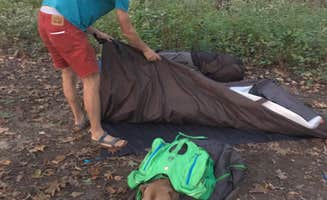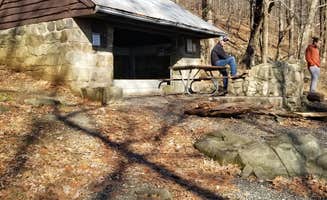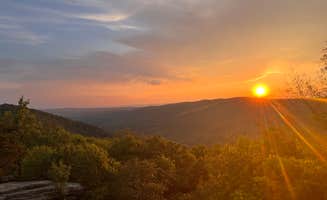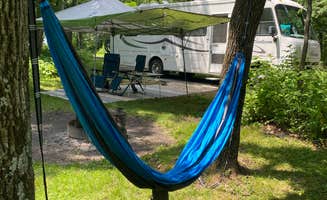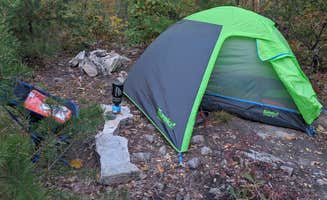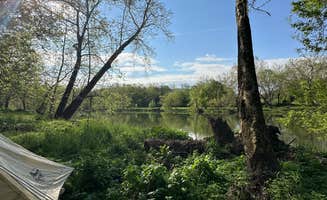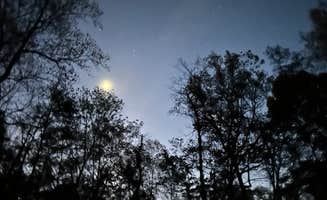Rustic camping near Brambleton, Virginia centers around the forests and river systems that form the eastern slopes of the Blue Ridge Mountains, with elevations ranging from 500 to 3,000 feet. The area experiences four distinct seasons with summer temperatures averaging 75-85°F during the day and dropping to 55-65°F at night. Most primitive sites lack potable water sources, requiring campers to either filter from streams or bring their own supply.
What to do
Stream fishing access: The South Fork Shenandoah River offers multiple riverside camping locations with direct fishing access. At South Fork Shenandoah River, campers can fish right from their sites. "We were right on the river, we swam and fished. There were plenty of walk in sites beyond ours," notes one visitor.
Waterfall hikes: Multiple trails lead to scenic waterfalls throughout the region. One camper at Shenandoah National Park Dispersed Sites mentioned, "I stayed in the area of overall run falls. Make sure to hang your food. There are plenty of black bears in the area."
Wildlife viewing: Early morning and dusk provide opportunities for wildlife spotting. A camper reported: "2 deers came to visit us at night. Saw Momma and two baby black bears." Bringing binoculars helps with spotting wildlife from a safe distance.
Ridge hiking: For moderate day hikes with valley views, several trails climb to ridge tops. "It is about 4 miles up, so not too bad, but there is no water after the first mile," explains a hiker at Veach Gap, noting the 1,200ft elevation gain.
What campers like
Riverside camping spots: Sites directly on the Shenandoah River are highly sought after. One camper at South Fork Shenandoah River shared, "The site at the end of the road is beautiful. We stayed right at the end of the road, since we have a 30 foot RV, but there are sites you can walk to all the way down the river."
Ridgeline views: Campsites positioned on ridges provide panoramic valley views. A camper at Veach Gap - GWNF - Backpacking Site reported, "Breathtaking views of the Shenandoah River and surrounding mountains. Very much worth the 4 mile hike up to the site."
Solitude: Many dispersed sites offer privacy away from crowds. "There are 9 campsites, each with at least one fire ring, a tent pad and a picnic table, and there is a vault toilet in the middle. I arrive at 7:30pm on a Saturday in late August and thought I might be too late to get a spot but there were only two other groups there."
Easy site identification: At Little Fort Campground, campers appreciate the clear system for claiming sites. "You select a campsite by flipping a washer on a hook on the board from green to red. Flip it back when you leave."
What you should know
Limited water access: Many sites have no reliable water sources. "It is about 4 miles up, so not too bad, but there is no water after the first mile. I have seen a small trickle part way up the mountain, but don't count on it. Pack up all the water you will need for the day/evening/morning."
Vault toilet conditions: Toilet facilities at primitive sites can be basic. At Little Fort Campground, "There are permanent structure Vault toilets/outhouses. Nowhere to dump trash, pack it out when you leave."
Cell service limitations: Most areas have unreliable or no mobile coverage. "This app says T-Mobile access, I'm a T-Mobile customer, no reception at all but drive 5 minutes back down the mountain and you're good to go."
Seasonal flooding risk: Riverside sites can become unusable after heavy rain. "I went back early October to possibly camp again, shortly after the hurricane rains had passed. The sites were underwater or filled with river mud, making them completely un-campable."
Tips for camping with families
Start with Little Fort: For first-time primitive campers with children, Little Fort Campground offers a good introduction to rustic camping. "Great established free campground! Site had a fire pit, table, parking spot, and tent platform. Bathrooms and bear proof trash was provided. Nice trails/creek behind site."
Check trail difficulty: When planning hikes, assess the full route difficulty. One camper noted: "It is a pretty decent hike that requires a good amount of climbing and has great views at the top. There is a bathroom on the back end of the trail but it was a little dirty."
Prepare for insects: Bug activity can be intense, especially near water. "Yellow flies and mosquitos are bad out there." Bring appropriate repellent and nets if camping during warmer months.
Be bear aware: Teaching children proper food storage is essential in this region. "There are plenty of black bears in the area." All food should be secured in vehicles or proper bear containers, or hung from trees at least 10 feet high and 4 feet away from the trunk.
Tips from RVers
Site accessibility: Many primitive areas have rough access roads requiring careful navigation. At South Fork Shenandoah River, a camper noted, "The road was a little rough, but our 92 ford camper made it, just go slow."
Limited RV options: Only certain dispersed areas accommodate larger vehicles. "We stayed right at the end of the road, since we have a 30 foot RV, but there are sites you can walk to all the way down the river. I saw one other site before ours."
Pack out all waste: With no dump stations at most primitive sites, RVers must be self-contained. "Nowhere to dump trash, pack it out when you leave. Seriously please take the trash with you so someone else doesn't have to clean it up."
Weekend planning: For weekend trips, arrive early to secure spots. "Got the last site at 6PM on the Friday of Memorial Day weekend," reported one camper at Little Fort Campground, highlighting the need for early arrival.


